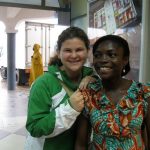At some point in the upbringing of most American citizens comes a time when they’re introduced to a bevy of cultural norms in the U.S. The shopping mall, Wal-Mart, Costco, conventions, and music festivals are just some of the experiences to be had in understanding consumer behavior in this country.
I mentioned all of the above experiences in an attempt to exemplify my exposure to Kumasi’s open air market, Kejetia, this past weekend. Take all of the elements of the typical American experiences and compress them into the heart of Kumasi. Add tens of thousands of patrons and shop keepers and you essentially have Kejetia. Then again, that description doesn’t even cover half of what it really is.
Our group’s trip to the market became the centerpiece of the weekend excursion in Ghana’s second largest city. The market plays host to an endless sea of shops bearing every food and and appliance anyone could ever need.
What the place didn’t offer was a sense of direction. Ghana’s lack of street signs and plotted geography translated into Kejetia’s perplexing passage ways. The market resides in a large bowl in the center of Kumasi and offers little visibility of above ground. It’s truly a labyrinth (to non-locals at least).
We took a quick tour of Kejetia which proved to be more challenging than it sounds. We trudged through uneven grounding, countless shop keepers and infinite sections of fabric, meat, vegetables, cooking supplies, etc. Touring the area in a group of 16 proved to be extremely difficult given how many factors contributed to our potential separation from one another. Even as you tried to keep your eyes on the person in front of you, you’d either be stampeded by shop keepers or patrons, grabbed by vendors, or tripped by the ground. The effort to stay together became strenuous and sight seeing turned into an exercise rather than a luxury.
This market sells everything. There are specific sections across Kejetia consisting of anything from meat to electronics to vegetables to cooking appliances to suitcases. Some sections were more bearable than others. The meat market, for example, was a spectacle. It’s a stretched out warehouse about the size of a football field filled with raw meat, sweating vendors and no ventilation. It didn’t stir up an appetite so much as it created skepticism as to how well the meat was procured or even what animal each hunk originally came from.
While migrating through the market we interacted with almost everyone we passed. The locals were infatuated with our nationality and limited Twi speaking abilities. They were delighted and mostly delightful in their exchanges with us. I wanted to peruse more of the market and take a closer look at the shops, but the adventure became more about survival rather than expenditure. I at least ended up purchasing some fabric to be tailored into exotic clothes when I returned home.
The experience only lasted an hour, but it will no doubt stick with me for the rest of my life. It was unlike any shopping trip I’ve ever embarked on. Despite the trials and tribulations of exploring it, I appreciate every moment of my experience on Saturday. I hope to one day return to the labyrinth and do some more Twi speaking, bargaining, and culture absorbing.



Comments by jaclynr